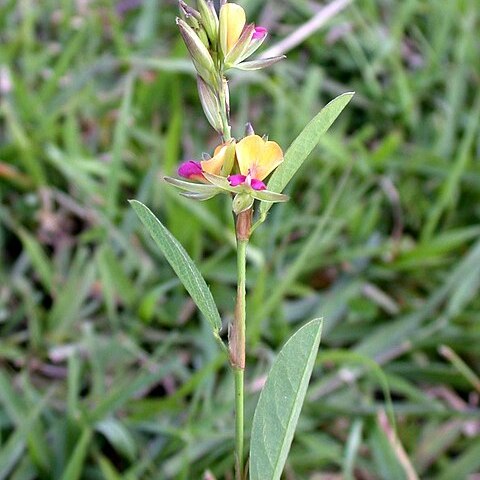Erect, prostrate or ascending, robust annual or perennial somewhat suffruticose herb 0.3-1(2) m tall. Stems pubescent, pilose or practically glabrous. Leaves 1-foliolate or less often pinnately 3-foliolate; leaflets 1.5-11 x 0.2-2.3 cm, oblong, ovate-lanceolate, linear-lanceolate or linear, acute and mucronulate at the apex, rounded or subcordate at the base, finely puberulous and with longer hairs beneath, slightly reticulate; petiole 2-17 mm long; petiolules 0.5-1.5 mm long; stipules 0.5-3 cm long, lanceolate. Inflorescences axillary, terminal or leaf-opposed, dense to lax; peduncle 1-3 cm long; rhachis 3-20 cm long; pedicels 2-5 mm long; primary bracts 5-10 x 3 mm, elliptic, acuminate, glabrous or pubescent, ciliate, deciduous; secondary bracts 1-2.5 mm long, linear, or sometimes lacking. Calyx glabrous to densely pubescent; tube 1-1.5 mm long; teeth 5-8(9.5) x 1.5-2.5 mm, lanceolate, acuminate, imbricate, noticeably rounded or subcordate at the base, ciliate with white or brownish hairs. Standard whitish, pinkish-buff, reddish-purple or bluish, 6-7 x 3 mm, obovate; keel often greenish. Fruit 5-10 mm long, scarcely exserted from the calyx, much constricted between the articles; articles 3-6, 1-1.5 x 2-2.5 mm, transversely elliptic, with strong, close transverse ridges which join up here and there, or with a raised more regular reticulation, glabrous or pubescent. Seeds olive, compressed, 1.5 x 0.8 mm, squarish.
Herbs, perennial. Stem erect, to 1.5 m tall, glabrous or pilose. Leaves 1-foliolate; petiole 3-9 mm, glabrous or pilose; blade oblong, rarely orbicular or linear-lanceolate, 2-6 × 0.2-1 cm, abaxially pilose and villous on veins, adaxially glabrous, base rounded, margin entire, ciliate, apex acute. Racemes terminal and axillary, 2-5 cm, 10-24-flowered, binate at each node. Pedicel 2-3 mm, pubescent. Calyx glabrous, 4-10 mm, longer than first article of legume. Corolla white, ca. 4 mm; standard obovate. Ovary glabrous, 3-5-ovuled. Legume moniliform, swollen, glabrous, 3-5-jointed; article broader than long, prominently transversely ridged, articles enclosed in calyx or slightly exserted. Fl. Sep, fr. Sep-Nov. 2n = 16*.
An erect herb or shrub. It has a woody rootstock. It grows up to 40-60 cm tall. The leaves are sword shaped. They are 2-5 cm long by 0.7-1.5 cm wide. The ends of the leaves are blunt. The flowers are at the end of the branch. It has a pea like flower. There are yellow and mauve colours on the flower. The pod is 1 cm long by 0.3 cm wide. The pod is constricted between the seeds. These sections break off. They have marks across them. The seed is dark brown and oval. It is 1.5-2 mm long by 1.5 mm wide.
Leaves 1-foliolate or less often pinnately 3-foliolate; leaflets 1.5–11 × 0.2–2.3 cm, oblong, ovate-lanceolate, linear-lanceolate or linear, acute and mucronulate at the apex, rounded or subcordate at the base, finely puberulous and with longer hairs beneath, slightly reticulate; petiole 2–17 mm long; petiolules 0.5–1.5 mm long; stipules 0.5–3 cm long, lanceolate.
Inflorescences axillary, terminal or leaf-opposed, dense to lax; peduncle 1–3 cm long; rhachis 3–20 cm long; pedicels 2–5 mm long; primary bracts 5–10 × 3 mm, elliptic, acuminate, glabrous or pubescent, ciliate, deciduous; secondary bracts 1–2.5 mm long, linear, or sometimes lacking.
Fruit 5–10 mm long, scarcely exserted from the calyx, much constricted between the articles; articles 3–6, 1–1.5 × 2–2.5 mm, transversely elliptic, with strong, close transverse ridges which join up here and there, or with a raised more regular reticulation, glabrous or pubescent.
Caule glabro lineâ decurrente pilosâ notato, foliis lineari-lanceolatis obtusis subtùs et margine pubescentibus, stipulis petiolo longioribus, leguminis articulis 4-5 subrotundo-compressis transverse rugosis.
Calyx glabrous to densely pubescent; tube 1–1.5 mm long; teeth 5–8(9.5) × 1.5–2.5 mm, lanceolate, acuminate, imbricate, noticeably rounded or subcordate at the base, ciliate with white or brownish hairs.
Erect, prostrate or ascending, robust annual or perennial somewhat suffruticose herb 0.3–1(2) m tall.
Standard whitish, pinkish-buff, reddish-purple or bluish, 6–7 × 3 mm, obovate; keel often greenish.
Small red flowers hidden in the glume-like calyx.
Seeds olive, compressed, 1.5 × 0.8 mm, squarish.
Stems pubescent, pilose or practically glabrous.
A diffusely branched herb

